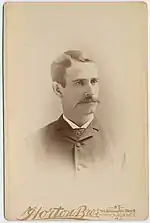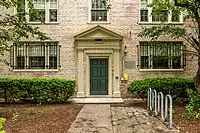Charles V. Chapin
Charles Value Chapin, M.D. (January 17, 1856 – January 31, 1941) was an American pioneer in public health research and practice during the Progressive Era. He was superintendent of health for Providence, Rhode Island between 1884 and 1932. He also served as President of the American Public Health Association in 1927. His main fields of operation were working in the bacteriological laboratory, organizing public health measures, and publicizing urgent public health needs. His popular reputation came from his strong attacks on popular misconceptions, such as that filth caused disease; that diseases were indiscriminately transmitted through the air, often accompanied by bad smells; and that disinfection was a cure-all for many sanitary evils.[1]
Dr. Charles Value Chapin | |
|---|---|
 | |
| Born | January 17, 1856 |
| Died | January 31, 1941 (aged 85) |
| Education | Brown University, Bellevue Medical College |
| Occupation | Superintendent of Health for Providence, Rhode Island |
| Years active | 1884-1932 |
| Known for | American pioneer in public health research and practice |
| Medical career | |
| Field | Public Health |
| Notable works | The Sources and Modes of Infection (1910), A Report on State Public Health Work Based on a Survey of State Boards of Health (1915) |
| Awards | Marcellus Hartley Medal, Public Welfare Medal, Sedgewick Medal |
His scientific observations on the nature of the spread of infectious disease gained widespread support. His book, The Sources and Modes of Infection, influenced physicians and public health officials across United States and Europe by demonstrating the central importance of the human carrier who does not have the symptoms of the disease but carries the germs and spreads it. He ignored the public health implications of pollution in the air and water supply, and hazardous chemicals, because germs were not involved.[2]
Early life

He was born in Providence, on January 17, 1856. He attended Mowry and Goff School then Brown University, graduating in 1876.[3] He began his medical education at New York’s College of Physicians and Surgeons, then transferred to Bellevue Hospital Medical College.[3] He began his medical practice in 1880, but did not have a warm bedside manner. He was drawn more toward theory and statistics.
Public Health career
Chapin became the superintendent of health for Providence in 1884,[4] and faced several public health crises during his tenure.
Cholera epidemics
Cholera epidemics threatened Providence several times during the 1880s; Chapin's response was to make personal inspections of every home and tenement in the city to remedy problems.[3]
Influenza pandemic
In early September 1918, the first cases of the Spanish flu started appearing.[3] By the end of the month, Chapin had identified over 2,500 cases. Chapin and other officials responded by ordering more hospital beds and increased staffing.[3]
Chapin did not believe that mass closures would be effective in combating the pandemic, but nevertheless did not oppose it when the Providence Board of Health issued a general closure order on October 6.[3] The spread of the influenza reached its highest level in mid-October, dipped for a few weeks, then returned for a smaller second wave in January 1919.[3] By February 5, no new cases were reported and the pandemic was declared over.[3]
Other positions
Chapin taught physiology at Brown starting in 1882.[5] His title in 1892 was “Professor of Physiology and Director of Physical Culture” and he reported on gymnastics and sports.[5]
Chapin served as president of the American Public Health Association in 1927. He retired as superintendent of health in 1932.[4]
Death and burial
He died on January 31, 1941 in Providence, Rhode Island.[4] He is buried at Swan Point Cemetery.[6]
Publications and accomplishments
C. V. Chapin became a pre-eminent public health official in the United States. With a career spanning 48 years, he served as the Superintendent of the Providence Department of Health and was hailed as the "Dean of City Health Officials".[7] He became President of the American Public Health Association and won numerous awards from this organization. He served as President of the American Epidemiological Society. He also received the W.T. Sedgwick Medal of the APHA. He won honorary degrees from Brown University, Rhode Island State College, and Yale, where C.-E. A. Winslow was chair.
He was a prolific writer. Two of his classic works were The Sources and Modes of Infection (1910) and A Report on State Public Health Work Based on a Survey of State Boards of Health (1915). Six of his papers were in the category of public-health administration, five were in communicable diseases and five were published in epidemiology and vital statistics. Later review found five of the papers particularly noteworthy, including The Fetich of Disinfection (1906), and Studies in Air and Contact Infection at the Providence City Hospital (1911). These two contained the basic tenets of the Sources and Modes of Infection cited above. He published on the administrative and resource aspects of the public's health, in How Should We Spend the Health Appropriation? (1913). His contributions to community hygiene and sanitary science were considered lasting. He led successful community hygiene practices to combat the pandemic flu of 1918 at Providence.[8]
Chapin taught that diseases come from germs, carried by persons or animals and not things, and that they are spread only by contact, food, and animal carriers. He inspired others to evaluate all of the collective efforts of community hygiene in terms of outcomes, an early effort to quantify the social sciences aspect of public-health practice. Further, he was a forerunner to the notion of health disparities among the poor, having published Deaths among Taxpayers and Non-Taxpayers (1924), an early connection of health and economic status. In 1926 he published Changes in Contagious Diseases, which described the variety of infectious agents in smallpox vs. scarlet fever. Altogether he published more than 113 titles. During his lifetime it was written that his contributions to the philosophy and methodology of public health were greater than "any living man". He was compared to his forerunners in the field, Frank, Edwin Chadwick, Simon, Lemuel Shattuck, William Thompson Sedgwick, and Hermann Biggs, as one of the greats of all time in public health.[9]
Legacy and honors

Brown University awarded Chapin with an honorary Sc.D. degree in 1909[10] and the Susan Colver Rosenberger Medal in 1935.[5] There is also a Brown University dormitory that bears his name.
The Providence City Hospital was renamed the Charles V. Chapin Hospital in 1931 to recognize his substantial contributions to improving the sanitary condition of the city of Providence. The State Laboratory building in Providence, housing state public health, environmental and forensic laboratories, is named the Charles V. Chapin building.
In 1928 he was awarded the Public Welfare Medal from the National Academy of Sciences.[11] He received the first Sedgwick Memorial Medal in 1929.
Publications
- Municipal Sanitation in the United States. Snow & Farnham, Providence, RI. 1901.
- The Sources and Modes of Infection. John Wiley & Sons, New York. 1910.
References
- James H. Cassedy, Charles V. Chapin and the Public Health Movement (1962).
- Cassedy, 2000
- "Charles Value Chapin and Providence Public Health". Influenza Encyclopedia. University of Michigan Center for the History of Medicine and Michigan Publishing, University of Michigan Library. Retrieved 6 June 2020.
After graduating from Brown University in the spring of 1876,
- "Dr. Chapin Is Dead. Health Authority. Superintendent of Bureau in Providence 48 Years Until 1932 Is Stricken at 85. He Won Medals For Work. Cited by League of Nations in 1925 for 'Revolutionizing Principles of Disinfection'". The New York Times. February 1, 1941. Retrieved 2015-03-08.
Dr. Charles V. Chapin, whose theories on public health problems have been adopted throughout the world, and who was Superintendent of Health here for forty-eight years until he retired in 1932, died today at the age of 85. ...
- Mitchell, Martha (1993). Encyclopedia Brunoniana. Providence, RI: Brown University Library. Retrieved 6 June 2020.
- "Burial Information". Swan Point Cemetery. Retrieved 6 June 2020.
- Milton Terris. 1999. "Charles V. Chapin (1856-1941), 'Dean of City Health Officers'". Journal of Public Health Policy 20(2):214-220.
- Barry, John M. (2004). The Great Influenza: The Epic Story of the Greatest Plague in History. Viking Penguin. ISBN 0-670-89473-7.
- These comments and summary of the man and his work were written C.E.A. Winslow.
- "Honorary Degrees: 1900s". Brown University. The Corporation of Brown University. Retrieved 6 June 2020.
- "Public Welfare Award". National Academy of Sciences. Archived from the original on 4 June 2011. Retrieved 14 February 2011.
Further reading
- Cassedy, James H. (1999). "Chapin, Charles Value (1856-1941)". doi:10.1093/anb/9780198606697.article.1300271. Cite journal requires
|journal=(help) - Cassedy, James H. Charles V. Chapin and the public health movement (Harvard University Press, 1962). A scholarly biography.
- Fee, Elizabeth and Dorothy Porter. "Public health, preventive medicine and professionalization: England and America in the nineteenth century". in Medicine in Society, Andrew Wear, editor. Cambridge University Press, 1992.
- Goldowsky, S. J. "Charles V. Chapin: his influence on concepts of public health." Rhode Island medical journal 62.8 (1979): 313-322.
- Mitchell, Martha (1993). "Chapin, Charles V." Encyclopedia Brunoniana. Retrieved 2019-10-30.
- Schultz, Stanley K., and Clay McShane. "To engineer the metropolis: sewers, sanitation, and city planning in late-nineteenth-century America." Journal of American History (1978): 389-411. in JSTOR
Primary sources
- Chapin, Charles Value. Papers of Charles V. Chapin, MD: a review of public health realities (The Commonwealth Fund, 1934)
- Chapin, Charles V. "The value of human life." American Journal of Public Health 3.2 (1913): 101-105. online
- Chapin, Charles Value. Municipal sanitation in the United States (1900) online
- Rhode Island. State Board of Health. Sanitary legislation in the United States : enacted during the year 1906 / compiled for the State Board of Health by Charles V. Chapin online